Abstract
Germanium phosphide (GeP), a rising star of novel two-dimensional (2D) material composed of Group IV–V elements, has been extensively studied and applied in photonics thanks to its broadband optical absorption, strong light–matter interaction and flexible bandgap structure. Here, we show the strong nonlinear optical (NLO) properties of 2D GeP nanoflakes in the broadband range with open-aperture Z-scan technique to explore the performance of 2D GeP microfiber photonic devices (GMPDs) in near-infrared (near-IR) and mid-infrared (mid-IR) ultrafast photonics. Our results suggest that employing the GMPD as an optical device in an erbium-doped fiber laser (EDFL) system results in ultrashort pulses and rogue waves (RWs) at 1.55 μm. Likewise, by the incorporation of GMPD into a thulium-doped fiber laser (TDFL) system, stable ultrashort pulse operation is also achieved at 2.0 μm. We expect these findings to be an excellent GMPD that can be applied in mode-locked fiber lasers to open up new avenues for its development and application in ultrafast photonics.
1 Introduction
Two-dimensional (2D) materials have attracted great interests due to their intriguing nonlinear optical (NLO) properties and extensively applied in various optical devices, including ultrashort pulse fiber lasers [1], [2], optical switching [3], [4], optical modulation [5], [6] and photodetectors [3], [7]. However, it is just getting started to explore NLO performances of new 2D materials. As a novel 2D material of Group IV–V compounds, 2D GeP in particular has recently attracted significant attentions of researchers in the field of optics. Interestingly, 2D GeP has appealing properties of tunable bandgap structure (0.51–1.68 eV) and large optical absorption [8], [9], evidencing its potentiality towards NLO devices in the broadband range. 2D GeP has been used as the excellent mode locker for 1.55-µm ultrashort pulse fiber laser [8]. On the other band, the reports on GeP-based photonic devices applied in ultrafast fiber laser at mid-infrared bands are limited.
Ultrashort pulse fiber lasers with their distinct advantages of low cost, convenient operation, high efficiency and excellent heat dissipation have attracted extensive research interests in various applications, such as frequency comb, medical surgery, optical imaging and micromachining [10], [11], [12], [13]. In general, the mode locking in fiber lasers by employing the NLO absorption properties of 2D materials can be regarded as one of the most efficient approaches to achieve ultrashort pulse generation. Up to now, the ultrashort pulse fiber lasers based on 2D materials at near-IR band have been widely investigated, including 1.0-µm fiber lasers [14], [15], [16] and 1.55-µm fiber lasers [17], [18]. In order to further promote the application and development of ultrashort pulses, it is greatly important to investigate the ultrashort pulse fiber lasers at mid-IR band. It is interesting to note that mid-IR ultrafast pulse fiber lasers have great potential applications in diversified fields, ranging from the medical diagnosis, military lidar, gas detection to material processing [19], [20], [21], [22]. In addition, ultrashort pulse fiber lasers can be considered as a suitable platform for observing the multiple pulse dynamics, such as the bound solitons [23], [24], noise-like pulses [25], [26] and rogue waves (RWs) [27], [28]. As an unpredictable wave, RW is a kind of special phenomenon in physical system and has been widely reported in numerous physical systems, including the oceanography, plasma physics, nonlinear optics and other fields [29], [30], [31], [32]. Studying its evolution process enables the control of extreme events. Besides, the observation of RWs has a beneficial effect on the generation of high-energy pulses in the laser systems [33]. Compared with other systems, the ultrashort pulse fiber laser can be used as a fascinating system to compliment an excellent test bed for the investigation of optical RWs [34], [35], [36]. Generally, multiple-pulse collision and pulse-to-pulse interactions with dispersive waves are significant factors in optical RWs generation [37], [38]. Furthermore, the combination of chaotic multiple-pulse dynamics and highly nonlinear effects in the fiber laser cavity are also favorable for generating optical RWs [39], [40]. Recently, the researchers have established that 2D GeP possesses not only the broadband nonlinear saturable absorption performances, but also stronger NLO responses [8], depicting its promising potential in optical RWs generation. Moreover, the 2D GeP-decorated microfiber photonic devices (GMPDs) have evidenced special structures with long-interaction length between light and 2D GeP material [41], effectively enhancing the nonlinear action for the multiple-pulse formation in ultrafast fiber lasers. Therefore, ultrafast fiber lasers with GMPDs could be a powerful bench for exploring optical RWs generation.
In this study, we have fabricated the 2D GeP nanoflakes by using the known liquid-phase exfoliation technique and investigate their NLO properties in near-IR and mid-IR bands by employing the typical open-aperture (OA) Z-scan technique. Besides, the GMPD was made by the optical deposition method and its saturable absorption response at both wavelengths was evaluated. Our main objective is to study the performances of GMPD in the erbium-doped fiber laser (EDFL) and thulium-doped fiber laser (TDFL) systems. Thanks to the excellent NLO properties of GMPD, we realized the ultrashort pulses and optical RWs in the EDFL for the first time. In addition, we also obtained the stable mode-locked pulses in the TDFL by using the GMPD as SA. Our experimental results suggest that GMPD can be used as an efficient NLO device in ultrafast photonics. Thus, the present work will be helpful to further study the NLO performances of Group IV–V compounds and enable them to be widely used in ultrafast nano-photonics.
2 Results and discussion
2.1 Characterizations of 2D GeP nanoflakes
Growth of GeP single crystals was achieved by a method similar to that previously reported [9]. Then 2D GeP nanoflakes were obtained by traditional liquid-phase exfoliation (LPE) method. Figure 1 shows the structure and morphological characteristics of the prepared 2D GeP nanoflakes. The transmission electron microscopy (TEM) in Figure 1A evidences the successful synthesis of 2D GeP nanoflakes. In addition, an obvious irregular 2D structure is revealed. The HR-TEM (high resolution TEM) image illustrated in Figure 1B clearly shows the lattice fringes, and its ∼0.27 nm spacing is consistent with the characteristics of GeP [8]. The thickness of 2D GeP nanoflakes was evaluated by using atomic force microscopy (AFM), as presented in Figure 1C. On careful investigation along the height profile of the white line in Figure 1C, it is understood that the GeP nanoflakes have an ultra-thin structure with 4.8 nm thickness (Figure 1D). Raman spectroscopy was also adopted to characterize the prepared GeP nanoflakes, as depicted in Figure 1E, highlighting three Raman peaks at ∼204.1, 248.4 and 365.1 cm−1. The linear optical absorption of 2D GeP from 300 to 2200 nm was also detected, as illustrated in Figure 1F. The strong optical absorption of 2D GeP in the broadband region is an evident for its great application prospect in advanced nanophotonic devices.
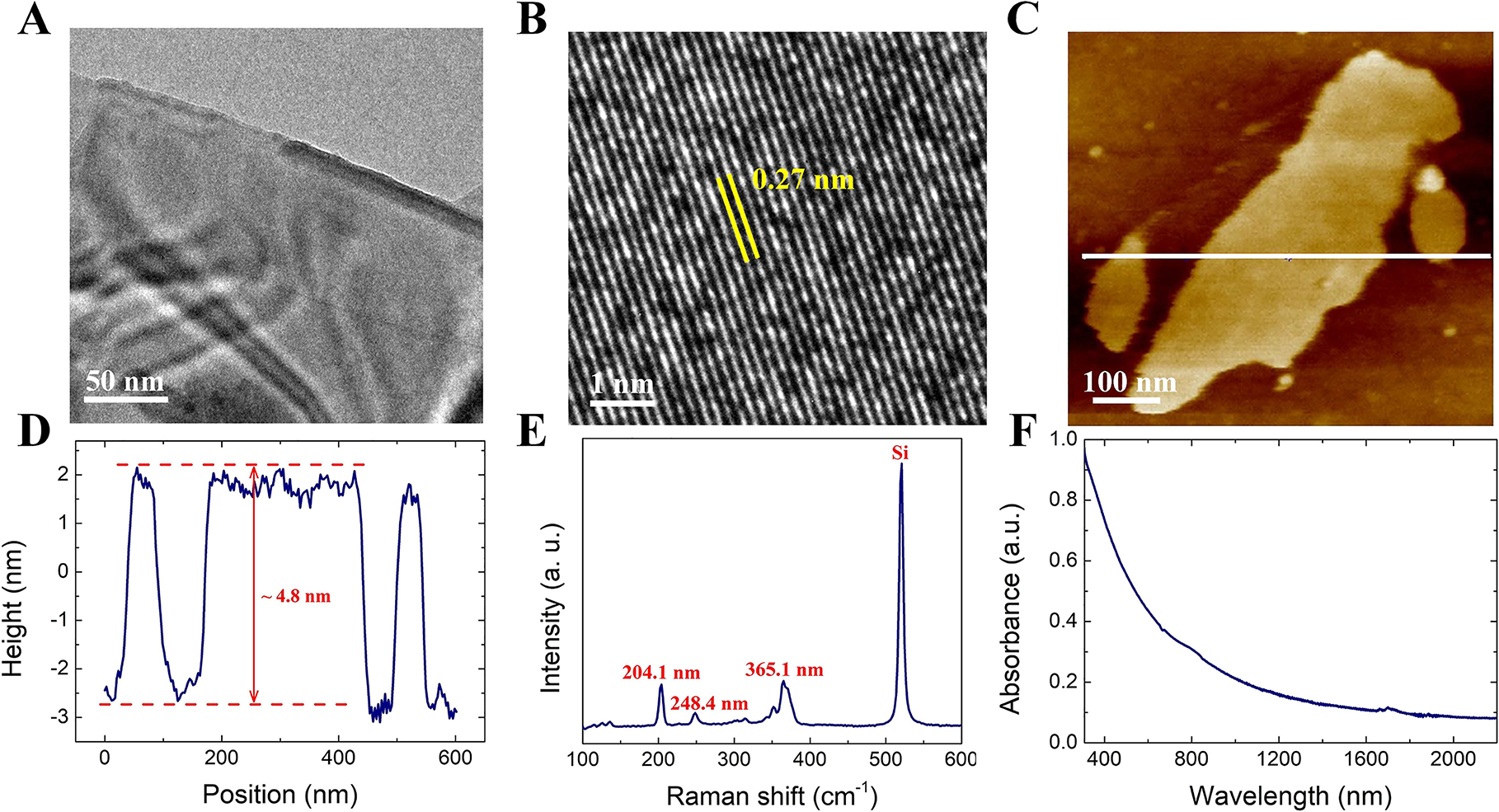
Characterization of 2D GeP nanoflakes. (A) TEM image. (B) HR-TEM image. (C) AFM image. (D) Height profile along the white line in (C). (E) Raman spectra. (F) Optical absorption spectrum.
2.2 Nonlinear optical properties of 2D GeP nanoflakes
The NLO response of 2D GeP was characterized by utilizing the OA Z-scan approach with femtosecond pulse sources excited at two different wavelengths (1550 and 1800 nm). Experimental setup is similar to that in the previous reported work [42]. In order to conduct Z-scan measurement, we fabricated the polymer composite film with 2D GeP nanoflakes. Consequently, the prepared composite film was then moved along the Z-axis and across the incident light. Figure 2A illustrates the measured results at 1550 nm. It is clearly noticed that there are two symmetric peaks located in the middle, suggesting the NLO of 2D GeP at 1550 nm. Besides, the transmission increases with the increment of the incident light intensity from 400 to 600 nJ. By processing the measuring data of Z-scan experiment, the nonlinear transmission behavior as a function of incident light intensity can be also obtained, as depicted in Figure 2B. The estimated saturation intensity is about 12.2 GW/cm2. The results of the Z-scan measurement at 1800 nm are shown in Figure 2C. Obviously, the symmetric peaks are also observed, indicating the broadband NLO response. Figure 2D depicts the corresponding nonlinear transmission with the increment of incident light intensity. The saturation intensity is calculated to be 68.3 GW/cm2.
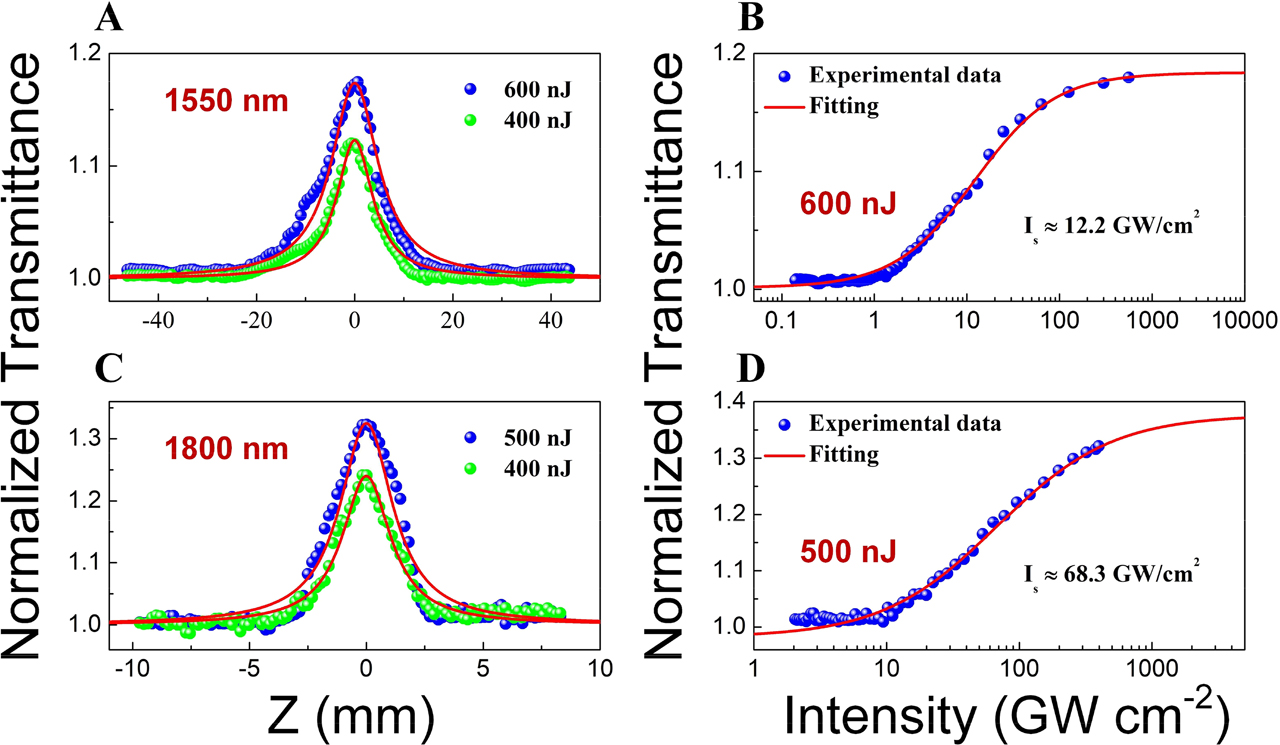
Characterization of the NLO responses of 2D GeP nanoflakes. OA Z-scan results at (A) 1550 nm and (C) 1800 nm, respectively. The normalized transmittance versus input peak intensity at (B) 1550 nm and (D) 1800 nm, respectively.
2.3 Saturable absorption performances of 2D GeP-decorated microfiber devices
The prepared few-layer 2D GeP nanoflakes were uniformly dispersed in the ethyl alcohol solution. The 2D GeP nanoflakes were subsequently deposited onto a microfiber as an optical device by means of the optical deposition technique [43]. Here, the microfiber was drawn by employing typical flame-brushing method [44]. The fabricated microfiber has a diameter of ∼15 µm with a low insert loss of ∼0.2 dB at communication band. In this process, the deposition length of GeP on microfiber is about 300 µm. Due to the long interaction length, there is strong evanescent field interaction with light propagating along the GeP sample, thereby greatly improving the damage threshold of GMPD. The nonlinear absorption transmission behavior of the GMPD at different wavelengths was eventually examined via the typical twin-power-meter measuring system, similar to that reported in the previous work [45]. The pump sources involved are the ultrafast EDFL (400 fs, 100 MHz, 1557 nm) and TDFL (1 ps, 6 MHz, 1900 nm). The GeP-decorated microfiber devices display typical intensity-dependent properties, as shown in Figure 3A and B. The optical modulation depths (ΔT) of the GMPDs at both wavelengths are 43.8 and 51.3%, respectively. Their corresponding non-saturable losses are 46.6 and 43.8%, respectively. The corresponding saturation intensities (Is) are 65.07 and 801.67 MW/cm2, respectively.
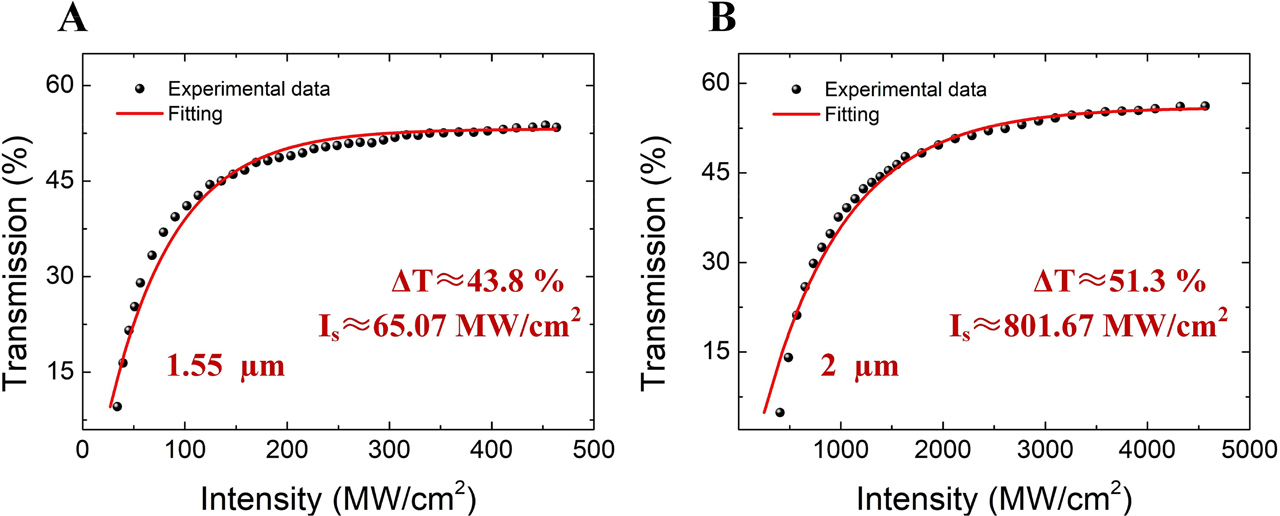
The nonlinear absorption transmission curves of GMPDs in (A) 1.55 µm and (B) 2 µm regions.
2.4 Ultrafast photonics applications
2.4.1 Ultrashort pulses and optical RWs in EDFL
The fabricated GMPD is used as a SA for an EDFL (see Figure S1 in the Supplementary material). Due to the strong saturable response of the GMPD, the ultrashort pulses are easily obtained by appropriately changing pump power and polarization controller (PC). Figure 4 shows the stable ultrashort pulses at a pump power of 200 mW. As depicted in Figure 4A, the optical spectrum has a center of 1560.4 nm. The corresponding full width at half maximum (FWHM) is ∼3.72 nm. Besides, the appearance of obvious Kelly sidebands seen from the optical spectrum shows that the EDFL operates in a soliton mode-locked state [46], [47]. Figure 4B illustrates the observed pulse trains. The temporal interval between two neighboring pulses is around 90.9 ns, corresponding to the fundamental frequency rate of 11 MHz. This also matches with the total length of EDFL cavity. The autocorrelation measurement is presented in Figure 4C. There is a FWHM of ∼1.4 ps. The pulse duration is ∼908 fs assuming a sech2 fitting. The corresponding time-bandwidth product (TBP) is calculated to be ∼0.416, which indicates the operation of slightly chirped pulses. The associated radio-frequency (RF) spectrum is given in Figure 4D. Obviously, there is a signal-to-noise ratio (SNR) of ∼74.9 dB, suggesting that the laser operation is relatively stable.
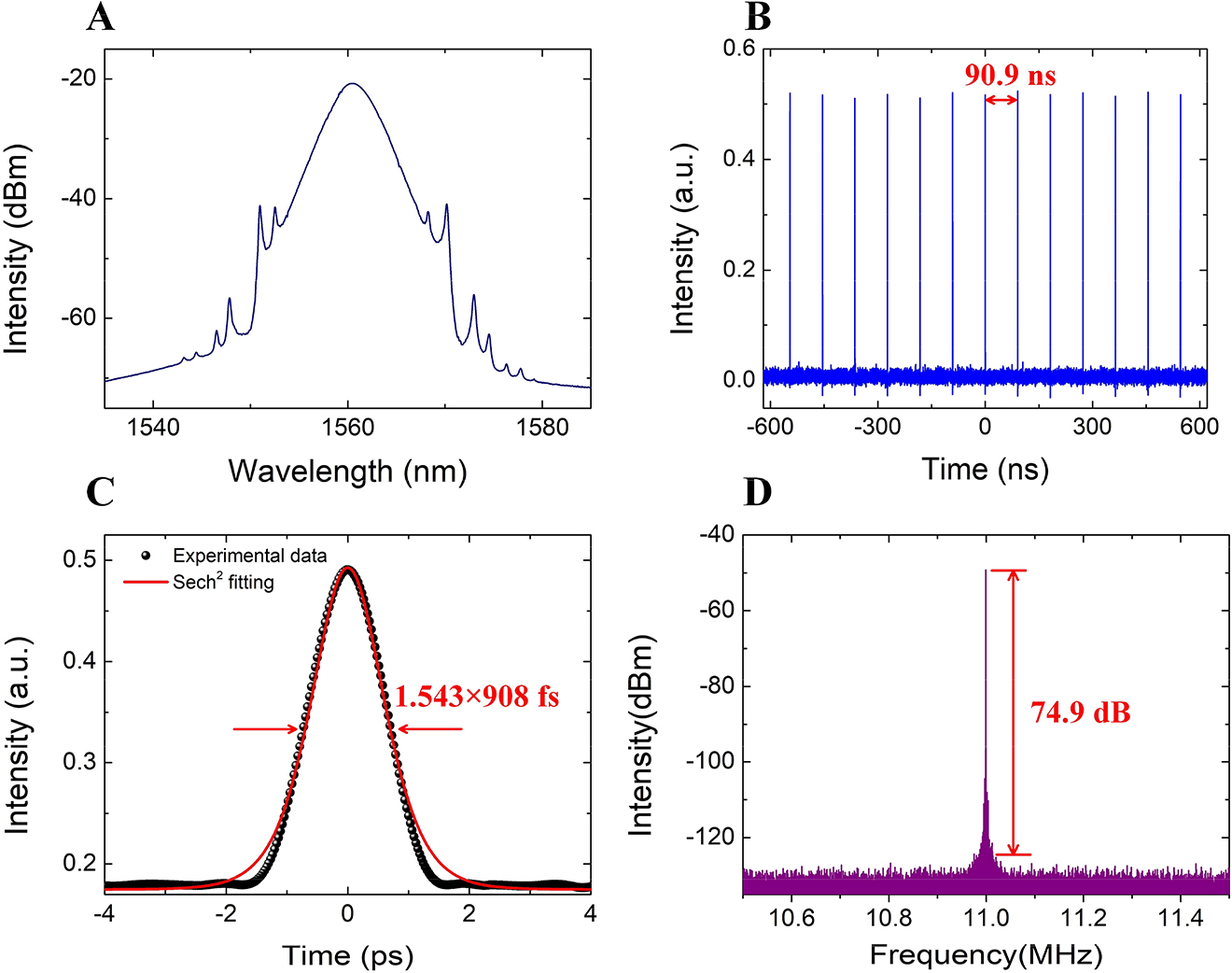
Mode-locked operation at 1550 nm. (A) Optical spectrum, (B) pulse trains, (C) autocorrelation trace, (D) RF spectrum.
It is widely known that when the pump power is at high level, the ultrafast fiber laser cavity easily generates the multiple pulses due to soliton energy quantization effect [48], [49]. Thus, with the pump power further increased, EDFL operates in the multiple-pulse state. With proper changes of PC, the chaotic multiple-pulse bunches can be obtained. The corresponding output characteristics at 400 mW are presented in Figure 5. The measured optical spectrum centered at 1559.1 nm is depicted in Figure 5A. Additionally, we can observe obvious Kelly sidebands from the optical spectrum. Figure 5B illustrates the temporal pulse trains measured by means of the real-time oscilloscope with 20-GHz bandwidth. As can be seen from the figure, there are several typical multiple-pulse bunches in the temporal domain. Furthermore, the intensities of multiple pulses among these bunches are random and even chaotic. The detailed view of single bunch is presented in Figure 5C. Obviously, the multiple-pulse bunch is composed of several smaller pulse bunches, in which there are random pulses with variational intensities. To study the amplitude fluctuations of these multiple-pulse bunches, the statistical distributions of pulse intensity are recorded. Figure 5D displays the corresponding histogram, exhibiting a non-Gaussian distribution. We further evaluated the significant wave height (SWH), demonstrating a value of ∼32.8 mV. The recorded maximum amplitude (RMA) is ∼111.2 mV, which is about 3.39 times that of the SWH. Generally, the judgment criterion of optical RWs is that the RMA is more than twice the SWH [27], [50], [51]. Thus, the events of chaotic multiple-pulse bunches can be considered as optical RWs since the RWA is around 3.39 times that of the SWH. In order to clearly illustrate the variation trend of optical RWs, Figure 6 displays the changing process of these chaotic multiple-pulse bunches at successive roundtrips, evidencing that the multiple-pulse packets with different amplitudes fluctuate randomly.
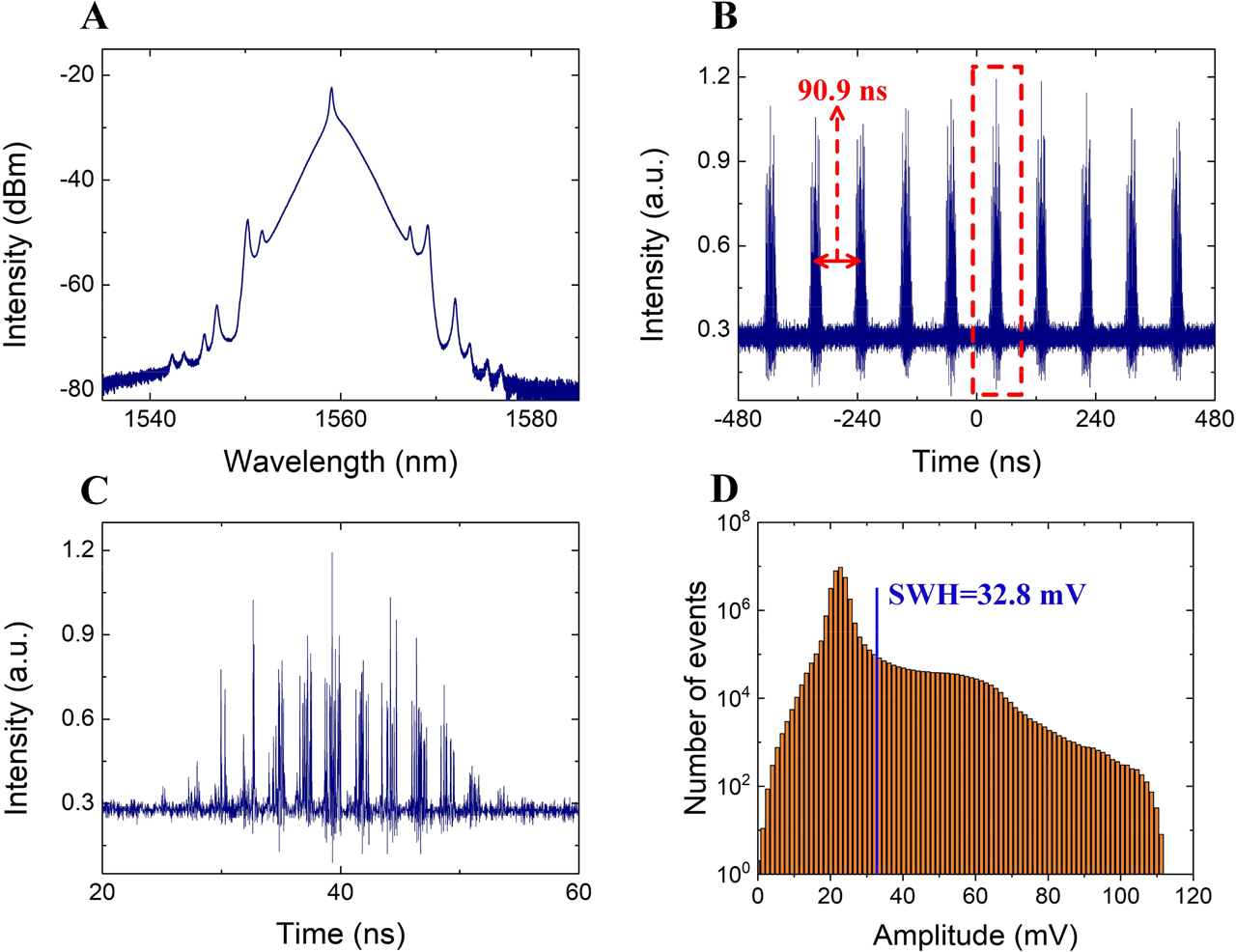
Multiple-pulse operation at 1550 nm. (A) Optical spectrum, (B) pulse trains, (C) magnified trains in red dashed part of (B), (D) intensity histogram.
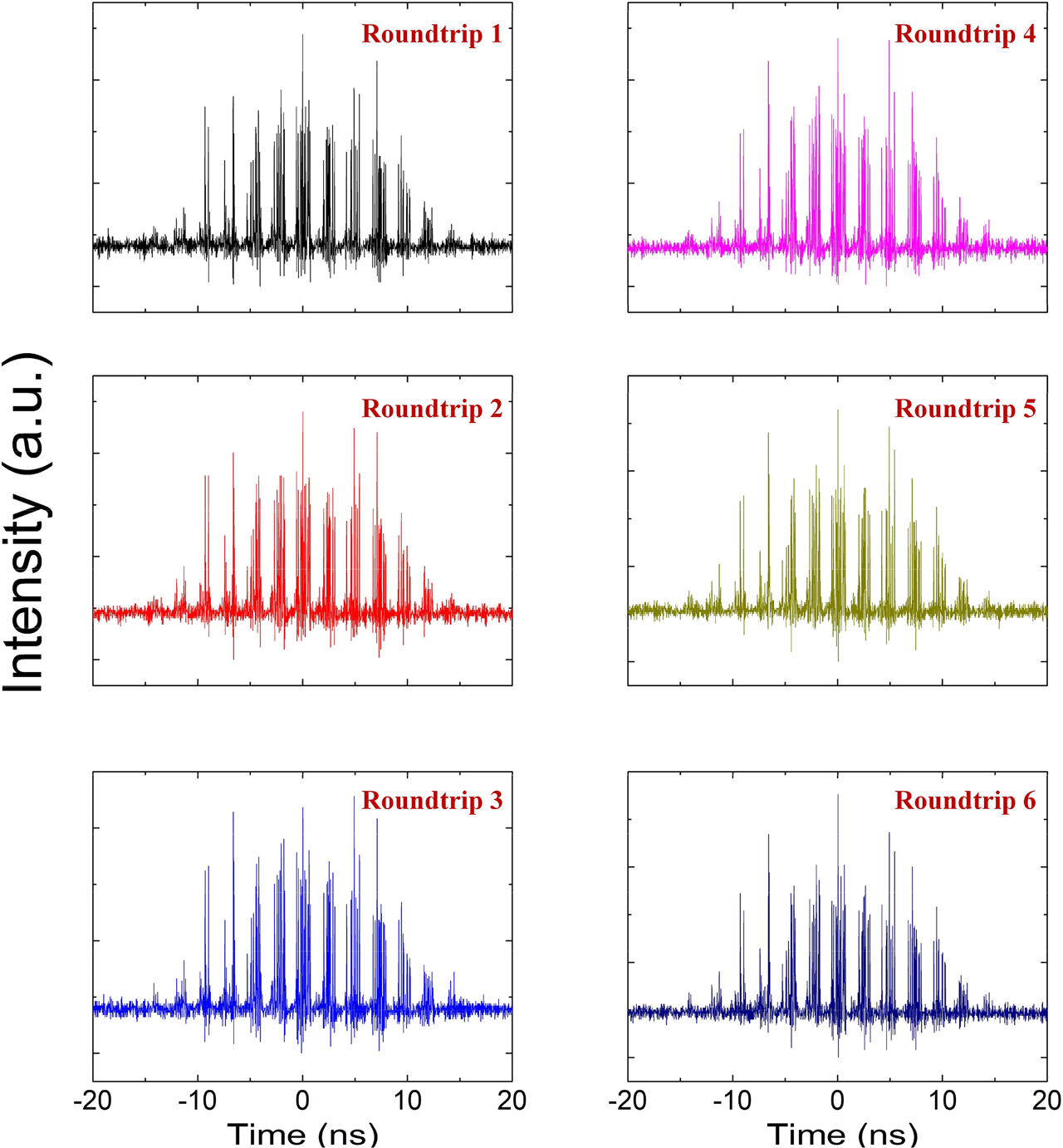
Evolution of multiple-pulse bunch over successive roundtrips.
Moreover, to further investigate the influence of pump power on the optical RWs generation, the statistical properties of chaotic pulse intensity are studied by keeping the PC fixed and boosting the pump power, as illustrated in Figure 7. It is worth noting that there are larger pulse-intensity fluctuations at higher pump power, indicating stronger interactions exist in the chaotic multiple-pulse bunches [28]. As can be seen from the figure, the histograms exhibit a statistical distribution with a long tail. In Figure 7A, the RMA is 122.9 mV, which is around 2.31 times larger than the SWH (37.1 mV). Meanwhile, the RMA value of 133.6 mV from Figure 7B is about 2.11 times larger than the SWH (42.9 mV). These experimental observations suggest that RWs are generated and even easily obtained at higher pump power level because of the threshold effect of pump power [28]. Furthermore, to check the effect of GeP nanosheets in the EDFL experiment, the GMPD is replaced by a 2D GeP SA based on a fiber connector. Irrespective of the pump power and the tuning of PC, the chaotic multiple-pulse operation is not obtained in the EDFL. Therefore, it can be concluded that the GMPD can play an important role in the formation of mode-locked pulses and optical RWs. In this experiment, the GMPD can not only be employed as the excellent saturable absorber, but also induce the highly nonlinear effects for the laser cavity [39], [40], which may facilitate the generation of chaotic multiple-pulse bunches.
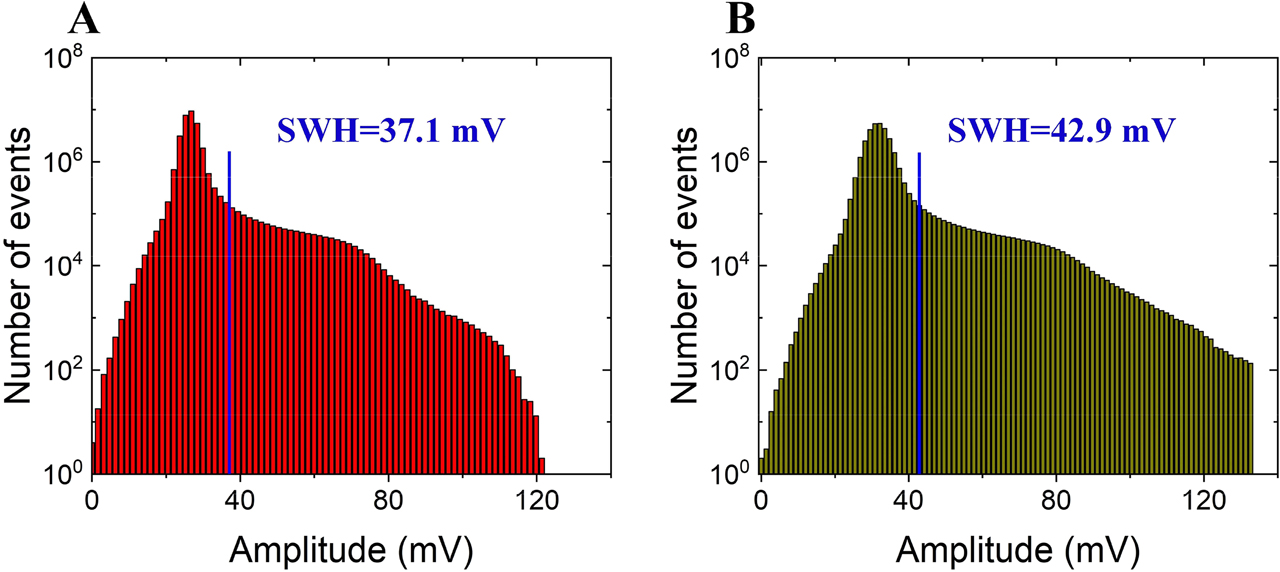
Intensity histograms of chaotic multiple-pulse bunch at (A) 500 mW and (B) 600 mW.
2.4.2 Ultrashort pulses in TDFL
To further explore the NLO absorption performances of the GMPD in mid-IR wavelength region, we also established a TDFL system (see Figure S1 in the Supplementary material). With increasing pump power to 280 mW, TDFL starts to operate in the continuous-wave (CW) regime. The stable mode locking is successfully realized by optimizing the PC and the pump power. At 900 mW, the pulse characteristics of typical mode-locked operation are displayed in Figure 8. Clearly, the typical Kelly sidebands can be observed, as seen in Figure 8A. The central wavelength is 1896 nm and the corresponding FWHM is 0.62 nm. Besides, a few characteristic dips are seen, resulting from the water absorption peak in air. Figure 8B shows measured pulse trains, having the temporal separation of 164.7 ns. Thus, the corresponding repetition rate is calculated to be 6.07 MHz that matches well with the cavity length. Figure 8C illustrates the measured autocorrelation trace with a FWHM of ∼9.87 ps, corresponding to a pulse width of 6.4 ps if a sech2 intensity profile is assumed. The TBP is estimated to be ∼0.331, which suggests the operation of slightly chirped pulses. The measured RF spectrum is displayed in Figure 8D. The SNR of ∼58 dB indicates that the fiber laser is relatively stable. The output power of stable pulses for different pump power is also evaluated, as illustrated in Figure 8E. It is obvious that the increasing trend is almost linear and the corresponding slope efficiency is ∼6.5%. The maximum output power of ultrashort pulses is around 58.4 mW, which is higher than that of the 2-µm fiber lasers with other 2D materials SA (Table 1). Moreover, the GMPD shows a higher modulation depth, exhibiting promising potential in the ultrafast photonics applications [52], [53]. Besides, the saturation intensities of SAs with various 2D materials in the 2 μm region are summarized (see Table S1 in the Supplementary material). It can be revealed that the GPMD exhibits typical nonlinear optical characteristics, indicating that 2D GeP exhibits promising potential in ultrafast photonics at 2.0 µm. To evaluate the stability of ultrashort pulse operation, the optical spectra are measured at different hours, as shown in Figure 8F. The spectral intensity and central wavelength are reasonably stable during the measurement period, suggesting the high-time stability of the TDFL with GMPD.
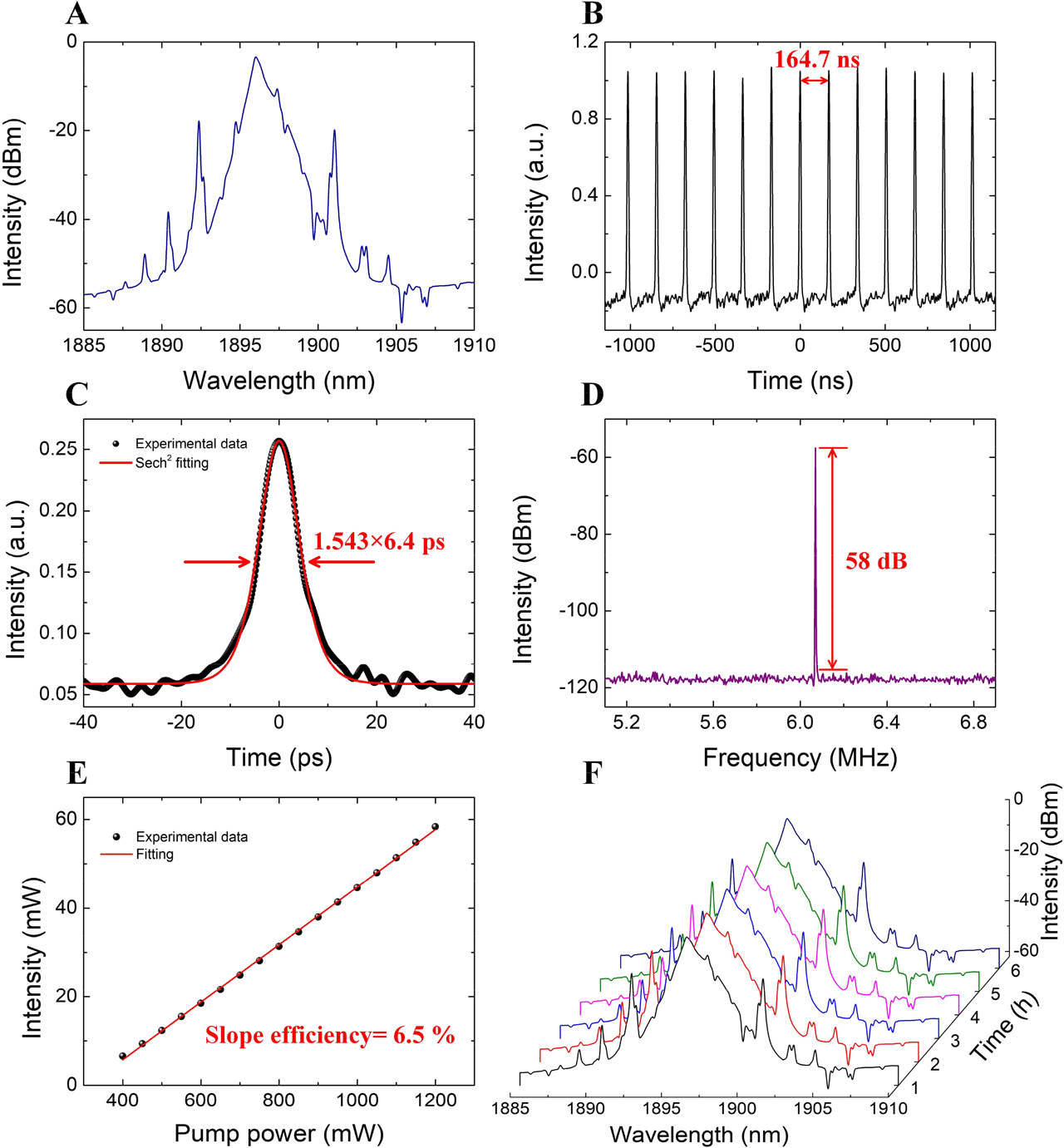
(A) Optical spectrum; (B) pulse trains; (C) autocorrelation trace; (D) RF spectrum; (E) relation between average output power and pump power; (F) optical spectra with different hours.
Summary of the pulse performance of ultrafast fiber lasers with different 2D material SAs at 2 µm.
| Material | ΔT (%) | λ (nm) | Width (ps) | Output (mW) | Refs. |
|---|---|---|---|---|---|
| Graphene | 4 | 1953.3 | 2.1 | 1.41 | [54] |
| BP | 9.8 | 1898 | 1.58 | <4 | [55] |
| Bi2Te3 | 9.8 | 1909.5 | 1.26 | <4 | [56] |
| WS2 | 10.9 | 1941 | 1.3 | 0.6 | [57] |
| WSe2 | 1.83 | 1886.22 | 1.18 | 32.5 | [58] |
| MXene | 49 | 1891.82 | 2.18 | 57.6 | [59] |
| GaTe | 30.7 | 1935.19 | 1.42 | 50.4 | [53] |
| GeP | 51.3 | 1896 | 6.4 | 58.4 | This work |
3 Conclusions
In summary, we have reported on the fabrication and characterization of 2D GeP nanoflakes with a special emphasis on their NLO applications in ultrafast photonics at near-IR and mid-IR bands. The Z-scan measurement of 2D GeP illustrates that it possesses the excellent saturable absorption properties. By taking advantage of the NLO characteristics of 2D GeP nanoflakes, the GMPD is fabricated and demonstrated its efficiency as an optical mode locker at wide wavelengths. With the incorporation of the GMPD into the EDFL, the chaotic multiple-pulse bunches are successfully obtained for the first time. The optical RWs generated from the chaotic multiple-pulse wave packet can possibly arise from the nonlinear interaction in the chaotic pulse bunches. Moreover, the TDFL based on the GMPD can be achieved and generate the stable ultrashort pulses at 2 µm. Our experimental results evidence the promising potential of 2D GeP in ultrafast photonics, which can offer a new direction for the application of Group IV–V compounds in nonlinear photonics.
4 Experimental section
4.1 Preparation of 2D GeP nanoflakes
In detail, 30 mg GeP single crystal and N-methyl pyrrolidone (NMP) solvent were grounded in agate mortar to obtain a small size GeP crystal. The GeP/NMP slurry was further collected and transferred to the probe ultrasonicator, and the sonication was performed at 300 W power in Ar atmosphere for 3 h. Subsequently, the mixture was placed in a beaker containing a large amount of NMP solvent and settled at an ultrasonic power of 400 W. In order to remove the residual large-size GeP crystal, the GeP/NMP mixture was centrifuged at 3000 rpm for 15 min. Finally, 2D GeP nanoflakes were obtained by centrifuging the supernatant at a higher centrifugation speed of 8000 rpm.
4.2 Characterization
The morphology and the thickness of the obtained 2D GeP nanoflakes were characterized by using TEM (FEI Tecnai G2 F30) and AFM (Bruker, Dimension ICON), respectively. A high-resolution confocal Raman microscope (WITec alpha 300R) with a laser wavelength of 532 nm was used to analyze the crystal structure of 2D GeP. By using UV–vis–NIR spectrometer (Cary 60, Agilent), we measured the linear absorption of the prepared 2D GeP nanoflakes and polymer composite film from ultraviolet to mid-IR optical region.
Funding source: State Key Research Development Program of China
Award Identifier / Grant number: 2019YFB2203503
Funding source: Key Research and Development Program of Guangdong Province
Award Identifier / Grant number: 2020B010169001
Funding source: Foundation and applied foundation research fund of Guangdong province
Award Identifier / Grant number: 2019A1515111060
Funding source: National Natural Science Foundation of China
Award Identifier / Grant number: 61705140
Award Identifier / Grant number: 61875132
Award Identifier / Grant number: 61875138
Acknowledgment
This work was supported by the State Key Research Development Program of China (Grant No. 2019YFB2203503), Key Research and Development Program of Guangdong Province (Grant No. 2020B010169001), Foundation and applied foundation research fund of Guangdong province (2019A1515111060) and National Natural Science Foundation of China (Grant Nos. 61705140, 61875132 and 61875138).
Author contributions: All authors have accepted responsibility for the entire content of this manuscript and approved its submission.
Research funding: This work was supported by the State Key Research Development Program of China (Grant No. 2019YFB2203503), Key Research and Development Program of Guangdong Province (Grant No. 2020B010169001), Foundation and applied foundation research fund of Guangdong province (2019A1515111060) and National Natural Science Foundation of China (Grant Nos. 61705140, 61875132 and 61875138).
Competing interests: Authors state no conflict of interest.
References
[1] J. He, L. Tao, H. Zhang, et al., “Emerging 2D materials beyond graphene for ultrashort pulse generation in fiber lasers,” Nanoscale, vol. 11, pp. 2577–2593, 2019, https://doi.org/10.1039/c8nr09368g.Suche in Google Scholar PubMed
[2] Y. Zhao, P. Guo, X. Li, et al., “Ultrafast photonics application of graphdiyne in the optical communication region,” Carbon, vol. 149, pp. 336–341, 2019, https://doi.org/10.1016/j.carbon.2019.04.075.Suche in Google Scholar
[3] T. Yu, H. Nie, S. Wang, et al., “Two-dimensional GeP-based broad-band optical switches and photodetectors,” Adv. Opt. Mater., vol. 8, 2020, Art no. 1901490, https://doi.org/10.1002/adom.201901490.Suche in Google Scholar
[4] L. Wu, Z. Xie, L. Lu, et al., “Few-layer tin sulfide: a promising black-phosphorus-analogue 2D material with exceptionally large nonlinear optical response, high stability, and applications in all-optical switching and wavelength conversion,” Adv. Opt. Mater., vol. 6, 2018, Art no. 1700985, https://doi.org/10.1002/adom.201700985.Suche in Google Scholar
[5] Z. Sun, A. Martinez, and F. Wang, “Optical modulators with 2D layered materials,” Nat. Photonics, vol. 10, pp. 227–238, 2016, https://doi.org/10.1038/nphoton.2016.15.Suche in Google Scholar
[6] C. Wang, Y. Wang, X. Jiang, et al., “MXene Ti3C2Tx: a promising photothermal conversion material and application in all-optical modulation and all-optical information loading,” Adv. Opt. Mater., vol. 7, 2019, Art no. 1900060, https://doi.org/10.1002/adom.201900060.Suche in Google Scholar
[7] N. Youngblood, C. Chen, S. J. Koester, et al., “Waveguide-integrated black phosphorus photodetector with high responsivity and low dark current,” Nat. Photonics, vol. 9, pp. 247–252, 2015, https://doi.org/10.1038/nphoton.2015.23.Suche in Google Scholar
[8] J. Guo, D. Huang, Y. Zhang, et al., “2D GeP as a novel broadband nonlinear optical material for ultrafast photonics,” Laser Photonics Rev., vol. 13, 2019, Art no. 1900123, https://doi.org/10.1002/lpor.201900123.Suche in Google Scholar
[9] L. Li, W. Wang, P. Gong, et al., “2D GeP: an unexploited low-symmetry semiconductor with strong in-plane anisotropy,” Adv. Mater., vol. 30, 2018, Art no. 1706771, https://doi.org/10.1002/adma.201706771.Suche in Google Scholar PubMed
[10] C. Gaida, T. Heuermann, M. Gebhardt, et al., “High-power frequency comb at 2 μm wavelength emitted by a Tm-doped fiber laser system,” Opt. Lett., vol. 43, pp. 5178–5181, 2018, https://doi.org/10.1364/ol.43.005178.Suche in Google Scholar PubMed
[11] K. D. Polder and S. Bruce, “Treatment of melasma using a novel 1,927-nm fractional thulium fiber laser: a pilot study,” Dermatol. Surg., vol. 38, pp. 199–206, 2012, https://doi.org/10.1111/j.1524-4725.2011.02178.x.Suche in Google Scholar PubMed
[12] M. E. Fermann and I. Hartl, “Ultrafast fibre lasers,” Nat. Photonics, vol. 7, pp. 868–874, 2013, https://doi.org/10.1038/nphoton.2013.280.Suche in Google Scholar
[13] R. R. Gattass and E. Mazur, “Femtosecond laser micromachining in transparent materials,” Nat. Photonics, vol. 2, pp. 219–225, 2008, https://doi.org/10.1038/nphoton.2008.47.Suche in Google Scholar
[14] D. Mao, S. Zhang, Y. Wang, et al., “WS2 saturable absorber for dissipative soliton mode locking at 1.06 and 1.55 µm,” Opt. Express, vol. 23, pp. 27509–27519, 2015, https://doi.org/10.1364/oe.23.027509.Suche in Google Scholar PubMed
[15] M. Zhang, G. Hu, G. Hu, et al., “Yb- and Er-doped fiber laser Q-switched with an optically uniform, broadband WS2 saturable absorber,” Sci. Rep., vol. 5, p. 17482, 2015, https://doi.org/10.1038/srep17482.Suche in Google Scholar PubMed PubMed Central
[16] J. Guo, R. Shi, R. Wang, et al., “Graphdiyne-polymer nanocomposite as a broadband and robust saturable absorber for ultrafast photonics,” Laser Photonics Rev., vol. 14, 2020, Art no. 1900367, https://doi.org/10.1002/lpor.201900367.Suche in Google Scholar
[17] J. Feng, X. Li, Z. Shi, et al., “2D ductile transition metal chalcogenides (TMCs): novel high-performance Ag2S nanosheets for ultrafast photonics,” Adv. Opt. Mater., vol. 8, 2019, Art no. 1901762. https://doi.org/10.1002/adom.201901762.Suche in Google Scholar
[18] J. Guo, Z. Wang, R. Shi, et al., “Graphdiyne as a promising mid-infrared nonlinear optical material for ultrafast photonics,” Adv. Opt. Mater., vol. 8, 2020, Art no. 2000067, https://doi.org/10.1002/adom.202000067.Suche in Google Scholar
[19] B. E. Bouma, L. E. Nelson, G. J. Tearney, et al., “Optical coherence tomographic imaging of human tissue at 1.55 um and 1.8 um using Er- and Tm-doped fiber sources,” J. Biomed. Opt., vol. 3, pp. 76–79, 1998, https://doi.org/10.1117/1.429898.Suche in Google Scholar PubMed
[20] M. Ebrahim-Zadeh and I. T. Sorokina, Mid-infrared Coherent Sources and Applications, Springer, 2008.10.1007/978-1-4020-6463-0Suche in Google Scholar
[21] W. Zeller, L. Naehle, P. Fuchs, et al., “DFB lasers between 760 nm and 16 µm for sensing applications,” Sensors, vol. 10, pp. 2492–2510, 2010, https://doi.org/10.3390/s100402492.Suche in Google Scholar PubMed PubMed Central
[22] J. Ma, Z. Qin, G. Xie, et al., “Review of mid-infrared mode-locked laser sources in the 2.0 μm–3.5 μm spectral region,” Appl. Phys. Rev., vol. 6, p. 021317, 2019, https://doi.org/10.1063/1.5037274.Suche in Google Scholar
[23] W. He, M. Pang, D. H. Yeh, et al., “Formation of optical supramolecular structures in a fibre laser by tailoring long-range soliton interactions,” Nat. Commun., vol. 10, p. 5756, 2019, https://doi.org/10.1038/s41467-019-13746-6.Suche in Google Scholar PubMed PubMed Central
[24] T. Feng, D. Zhang, X. Li, et al., “SnS2 nanosheets for Er-doped fiber lasers,” ACS Appl. Nano Mater., vol. 3, pp. 674–681, 2020, https://doi.org/10.1021/acsanm.9b02194.Suche in Google Scholar
[25] J. Liu, Y. Chen, P. Tang, et al., “Generation and evolution of mode-locked noise-like square-wave pulses in a large-anomalous-dispersion Er-doped ring fiber laser,” Opt. Express, vol. 23, pp. 6418–6427, 2015, https://doi.org/10.1364/oe.23.006418.Suche in Google Scholar PubMed
[26] J. Yin, F. Zhu, J. Lai, et al., “Hafnium sulfide nanosheets for ultrafast photonic device,” Adv. Opt. Mater., vol. 7, 2019, Art no. 1801303, https://doi.org/10.1002/adom.201801303.Suche in Google Scholar
[27] C. Lecaplain and P. Grelu, “Rogue waves among noiselike-pulse laser emission: an experimental investigation,” Phys. Rev. A., vol. 90, 2014, Art no. 013805, https://doi.org/10.1103/physreva.90.013805.Suche in Google Scholar
[28] P. Wang, D. Hu, K. Zhao, et al., “Dissipative rogue waves among noise-like pulses in a Tm fiber laser mode locked by a monolayer MoS2 saturable absorber,” IEEE J. Sel. Top. Quantum Electron., vol. 24, 2018, Art no. 1800207, https://doi.org/10.1109/jstqe.2017.2749972.Suche in Google Scholar
[29] K. Dysthe, H. E. Krogstad, and P. Müller, “Oceanic rogue waves,” Annu. Rev. Fluid Mech., vol. 40, pp. 287–310, 2008, https://doi.org/10.1146/annurev.fluid.40.111406.102203.Suche in Google Scholar
[30] H. Bailung, S. K. Sharma, and Y. Nakamura, “Observation of peregrine solitons in a multicomponent plasma with negative ions,” Phys. Rev. Lett., vol. 107, 2011, Art no. 255005, https://doi.org/10.1103/physrevlett.107.255005.Suche in Google Scholar
[31] D. R. Solli, C. Ropers, P. Koonath, et al., “Optical rogue waves,” Nature, vol. 450, pp. 1054–1057, 2007, https://doi.org/10.1038/nature06402.Suche in Google Scholar PubMed
[32] Z. Yan, “Vector financial rogue waves,” Phys. Lett. A., vol. 375, pp. 4274–4279, 2011, https://doi.org/10.1016/j.physleta.2011.09.026.Suche in Google Scholar
[33] N. Akhmediev, J. M. Soto-Crespo, and A. Ankiewicz, “How to excite a rogue wave,” Phys. Rev. A., vol. 80, p. 043818, 2009, https://doi.org/10.1103/physreva.80.043818.Suche in Google Scholar
[34] S. A. Kolpakov, H. Kbashi, and S. V. Sergeyev, “Dynamics of vector rogue waves in a fiber laser with a ring cavity,” Optica, vol. 3, pp. 870–875, 2016, https://doi.org/10.1364/optica.3.000870.Suche in Google Scholar
[35] A. Klein, G. Masri, H. Duadi, et al., “Ultrafast rogue wave patterns in fiber lasers,” Optica, vol. 5, pp. 774–778, 2018, https://doi.org/10.1364/optica.5.000774.Suche in Google Scholar
[36] B. Li, J. Kang, S. Wang, et al., “Unveiling femtosecond rogue-wave structures in noise-like pulses by a stable and synchronized time magnifier,” Opt. Lett., vol. 44, pp. 4351–4354, 2019, https://doi.org/10.1364/ol.44.004351.Suche in Google Scholar
[37] N. Akhmediev, J. M. Soto-Crespo, and A. Ankiewicz, “Could rogue waves be used as efficient weapons against enemy ships?,” Eur. Phys. J. Spec. Top., vol. 185, pp. 259–266, 2010, https://doi.org/10.1140/epjst/e2010-01253-8.Suche in Google Scholar
[38] A. Demircan, S. Amiranashvili, C. Brée, et al., “Rogue events in the group velocity horizon,” Sci. Rep., vol. 2, p. 850, 2012, https://doi.org/10.1038/srep00850.Suche in Google Scholar PubMed PubMed Central
[39] M. Liu, Z.-R. Cai, S. Hu, et al., “Dissipative rogue waves induced by long-range chaotic multi-pulse interactions in a fiber laser with a topological insulator-deposited microfiber photonic device,” Opt. Lett., vol. 40, pp. 4767–4770, 2015, https://doi.org/10.1364/ol.40.004767.Suche in Google Scholar PubMed
[40] Z. Cai, M. Liu, S. Hu, et al., “Graphene-decorated microfiber photonic device for generation of rogue waves in a fiber laser,” IEEE J. Sel. Top. Quantum Electron, vol. 23, 2017, Art no. 0900306, https://doi.org/10.1109/jstqe.2016.2568741.Suche in Google Scholar
[41] R. Khazaeinezhad, S. H. Kassani, H. Jeong, et al., “Ultrafast pulsed all-fiber laser based on tapered fiber enclosed by few-layer WS2 nanosheets,” IEEE Photonics Technol. Lett., vol. 27, pp. 1581–1584, 2015, https://doi.org/10.1109/lpt.2015.2426178.Suche in Google Scholar
[42] Y. Song, K. You, Y. Chen, et al., “Lead monoxide: a promising two-dimensional layered material for applications in nonlinear photonics in the infrared band,” Nanoscale, vol. 11, pp. 12595–12602, 2019, https://doi.org/10.1039/c9nr03167g.Suche in Google Scholar PubMed
[43] K. Kashiwagi and S. Yamashita, “Deposition of carbon nanotubes around microfiber via evanascent light,” Opt. Express, vol. 17, pp. 18364–18370, 2009, https://doi.org/10.1364/oe.17.018364.Suche in Google Scholar
[44] L. Tong, F. Zi, X. Guo, et al., “Optical microfibers and nanofibers: a tutorial,” Opt. Commun., vol. 285, pp. 4641–4647, 2012, https://doi.org/10.1016/j.optcom.2012.07.068.Suche in Google Scholar
[45] Z.-C. Luo, M. Liu, H. Liu, et al., “2 GHz passively harmonic mode-locked fiber laser by a microfiber-based topological insulator saturable absorber,” Opt. Lett., vol. 38, pp. 5212–5215, 2013, https://doi.org/10.1364/ol.38.005212.Suche in Google Scholar PubMed
[46] S. M. J. Kelly, “Characteristic sideband instability of periodically amplified average soliton,” Electron. Lett., vol. 28, pp. 806–807, 1992, https://doi.org/10.1049/el:19920508.10.1049/el:19920508Suche in Google Scholar
[47] L. Nelson, D. J. Jones, K. Tamura, et al., “Ultrashort-pulse fiber ring lasers,” Appl. Phys. B., vol. 65, pp. 277–294, 1997, https://doi.org/10.1007/s003400050273.Suche in Google Scholar
[48] D. Y. Tang, L. M. Zhao, B. Zhao, et al., “Mechanism of multisoliton formation and soliton energy quantization in passively mode-locked fiber lasers,” Phys. Rev. A., vol. 72, 2005, Art no. 043816, https://doi.org/10.1103/physreva.72.043816.Suche in Google Scholar
[49] A. B Grudinin, D. J. Richardson, and D. N. Payne, “Energy quantisation in figure eight fibre laser,” Electron. Lett., vol. 28, pp. 67–68, 1992, https://doi.org/10.1049/el:19920042.10.1049/el:19920042Suche in Google Scholar
[50] C. Lecaplain, P. Grelu, J. M. Soto-Crespo, et al., “Dissipative rogue waves generated by chaotic pulse bunching in a mode-locked laser,” Phys Rev Lett., vol. 108, p. 233901, 2012, https://doi.org/10.1103/physrevlett.108.233901.Suche in Google Scholar
[51] S Yufeng, W. Zhenhong, W. Cong, et al., “Recent progress on optical rogue waves in fiber lasers: status, challenges, and perspectives,” Adv. Photonics, vol. 2, 2020, Art no. 024001. https://doi.org/10.1117/1.AP.2.2.024001.Suche in Google Scholar
[52] C. Zhao, Y. Zou, Y. Chen, et al., “Wavelength-tunable picosecond soliton fiber laser with Topological Insulator: Bi2Se3 as a mode locker,” Opt. Express, vol. 20, pp. 27888–27895, 2012, https://doi.org/10.1364/oe.20.027888.Suche in Google Scholar PubMed
[53] M. Zhang, J. Li, H. Chen, et al., “Group IIIA/IVA monochalcogenides nanosheets for ultrafast photonics,” APL Photonics, vol. 4, 2019, Art no. 090801, https://doi.org/10.1063/1.5100848.Suche in Google Scholar
[54] Q. Wang, T. Chen, B. Zhang, et al., “All-fiber passively mode-locked thulium-doped fiber ring laser using optically deposited graphene saturable absorbers,” Appl. Phys. Lett., vol. 102, 2013, Art no. 131117, https://doi.org/10.1063/1.4800036.Suche in Google Scholar
[55] H. Yu, X. Zheng, K. Yin, et al., “Thulium/holmium-doped fiber laser passively mode locked by black phosphorus nanoplatelets-based saturable absorber,” Appl. Opt., vol. 54, pp. 10290–10294, 2015, https://doi.org/10.1364/ao.54.010290.Suche in Google Scholar PubMed
[56] K. Yin, B. Zhang, L. Li, et al., “Soliton mode-locked fiber laser based on topological insulator Bi2Te3 nanosheets at 2 μm,” Photon. Res., vol. 3, pp. 72–76, 2015, https://doi.org/10.1364/prj.3.000072.Suche in Google Scholar
[57] M. Jung, J. Lee, J. Park, et al., “Mode-locked, 1.94-μm, all-fiberized laser using WS2-based evanescent field interaction,” Opt. Express, vol. 23, pp. 19996–20006, 2015, https://doi.org/10.1364/oe.23.019996.Suche in Google Scholar PubMed
[58] J. Yin, J. Li, H. Chen, et al., “Large-area highly crystalline WSe2 atomic layers for ultrafast pulsed lasers,” Opt. Express, vol. 25, pp. 30020–30031, 2017, https://doi.org/10.1364/oe.25.030020.Suche in Google Scholar
[59] Z. Wang, H. Li, M. Luo, et al., “MXene photonic devices for near-infrared to mid-infrared ultrashort pulse generation,” ACS Appl. Nano Mater., vol. 3, pp. 3513–3522, 2020 https://doi.org/10.1021/acsanm.0c00241.Suche in Google Scholar
Supplementary Material
The online version of this article offers supplementary material (https://doi.org/10.1515/nanoph-2020-0248).
© 2020 Zhenhong Wang et al., published by De Gruyter, Berlin/Boston
This work is licensed under the Creative Commons Attribution 4.0 International License.
Artikel in diesem Heft
- Reviews
- Boron nitride for excitonics, nano photonics, and quantum technologies
- Design for quality: reconfigurable flat optics based on active metasurfaces
- Research Articles
- Microwave oscillator and frequency comb in a silicon optomechanical cavity with a full phononic bandgap
- Second harmonic generation in metasurfaces with multipole resonant coupling
- Symmetry-tailored patterns and polarizations of single-photon emission
- Highly transparent and conductive metal oxide/metal/polymer composite electrodes for high-efficiency flexible organic light-emitting devices
- Optical anapole mode in nanostructured lithium niobate for enhancing second harmonic generation
- Temporal plasmonics: Fano and Rabi regimes in the time domain in metal nanostructures
- Chemiluminescent carbon nanodots as sensors for hydrogen peroxide and glucose
- Dual-polarized multiplexed meta-holograms utilizing coding metasurface
- Tunable photoluminescence properties of selenium nanoparticles: biogenic versus chemogenic synthesis
- Compact disordered magnetic resonators designed by simulated annealing algorithm
- Controlling the plasmon resonance via epsilon-near-zero multilayer metamaterials
- 2D GeP-based photonic device for near-infrared and mid-infrared ultrafast photonics
- Purcell-enhanced emission from individual SiV− center in nanodiamonds coupled to a Si3N4-based, photonic crystal cavity
- Ultrasensitive and fast photoresponse in graphene/silicon-on-insulator hybrid structure by manipulating the photogating effect
- Multiresonant plasmonic nanostructure for ultrasensitive fluorescence biosensing
- Advanced encryption method realized by secret shared phase encoding scheme using a multi-wavelength metasurface
Artikel in diesem Heft
- Reviews
- Boron nitride for excitonics, nano photonics, and quantum technologies
- Design for quality: reconfigurable flat optics based on active metasurfaces
- Research Articles
- Microwave oscillator and frequency comb in a silicon optomechanical cavity with a full phononic bandgap
- Second harmonic generation in metasurfaces with multipole resonant coupling
- Symmetry-tailored patterns and polarizations of single-photon emission
- Highly transparent and conductive metal oxide/metal/polymer composite electrodes for high-efficiency flexible organic light-emitting devices
- Optical anapole mode in nanostructured lithium niobate for enhancing second harmonic generation
- Temporal plasmonics: Fano and Rabi regimes in the time domain in metal nanostructures
- Chemiluminescent carbon nanodots as sensors for hydrogen peroxide and glucose
- Dual-polarized multiplexed meta-holograms utilizing coding metasurface
- Tunable photoluminescence properties of selenium nanoparticles: biogenic versus chemogenic synthesis
- Compact disordered magnetic resonators designed by simulated annealing algorithm
- Controlling the plasmon resonance via epsilon-near-zero multilayer metamaterials
- 2D GeP-based photonic device for near-infrared and mid-infrared ultrafast photonics
- Purcell-enhanced emission from individual SiV− center in nanodiamonds coupled to a Si3N4-based, photonic crystal cavity
- Ultrasensitive and fast photoresponse in graphene/silicon-on-insulator hybrid structure by manipulating the photogating effect
- Multiresonant plasmonic nanostructure for ultrasensitive fluorescence biosensing
- Advanced encryption method realized by secret shared phase encoding scheme using a multi-wavelength metasurface

